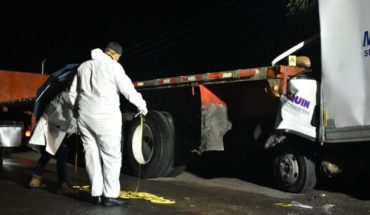THE HABANA (AP) — There are still broken tombstones and marbles lying on the floor. In some vaults, the vegetation beats the cement, but gradually the first Jewish cemetery in Cuba began to be rescued and, with it, the memory of this small community on the island.” I feel a very great peace and quiet when I visit the cemetery… For me, it’s like standing next to my mother, my only sister, and my nephew,” Adela Dworin, president of the Hebrew Board of Cuba, stood next to a tomb adorned with the little stones that Jewish relatives often use to pay homage to their dead.
Here and there you can see these rocks — an equivalent of flowers among Catholics — next to the plates that immortalize the name of a grandfather, a father or an aunt surrounded by stars of David and words of comfort in Yiddish. Elsewhere, a brigade of workers polishes the blades, cements streets, or frames a pantheon that was looted. HELP US Click the Google News star and follow us “Here are buried the people who came escaping fascism during the war, those who founded the community, who bought these lands to make it cemetery,” explained to AP David Prinstein, Vice-President of the Hebrew Board of Cuba. “It has historical and sentimental value.” The grounds of this Ashkenazi Jewish cemetery — an adjective that identifies the originating in Central and Eastern Europe — were purchased in 1906 by members of the first Hebrew society to be formed on the island, with people coming mostly from the United States, and it opened in 1910. Many other families also arrived during the period between world wars, fleeing the persecution to which they were subjected.
Workers polish a marble tomb in the Jewish cemetery in Guanabacoa, east of Havana, Cuba, on June 7, 2019. The restoration is the result of an initiative of the state Office of the City Historian, which is immersed in a maelstrom of preparations for the 500th anniversary of the founding of Havana in November. (AP Photo/Ramón Espinosa)
In another adjoining plot, decades later one of Sephardic tradition was installed, native to Spain.A few years ago, Prinstein and other community members estimated the budget to fix the cemetery at $200,000, but did not get the donations Necessary. Now the rescue is running by the state Office of the City Historian.About to turn 500 years old, Havana and the Historian’s Office are in a real maelstrom of preparations that includes from the arrangement of streets , passing through historical monuments, rescue of documents and valuable sites. As indicated to the local press, the engineer Pilar Vega, of the Office of the City Historian, there are about 1,100 vaults in the cemetery. Some 50 of these have already been repaired and another 150 are expected to be completed this year. An old special room was also arranged for the body purification washes of the dead required by the Jewish rite and a waiting room for families. Vega did not specify how much the state investment will amount to.
The portrait of a young Cuban soldier killed in the Indochina War decorates his grave in the Jewish cemetery of Guanabacoa, eastern Havana, Cuba, on June 7, 2019. Many Jewish families left the country after the 1959 revolution leaving behind their dead — who in this tradition should not be exhumed unless it is to take them to Israel. (AP Photo/Ramón Espinosa)
Away from the city center the necropolis is located in the peripheral capital municipality of Guanabacoa and usually remains closed to avoid sorties, so although the arrangements were initiated in the past months, it is now that the result of restoration with the cementation of the main street and the reconstruction of several of its facilities and main monoliths.” We are not the only problem that the country has, there are many places that require the attention of the Office of the Historian, so we are eternally grateful for their interest and friendship to the Jewish people,” said Dworin.Cuba is currently passing a economic crisis for lack of liquidity that includes difficulties in paying creditors and suppliers, which usually results in a kind of temporary oversupply of some products. The cemetery has a monument about three meters high that pays tribute to the six million Jews who died in the Nazi Holocaust. A half-dozen soaps made from human fat from concentration camps lie there.
Operators working on the restoration of a Jewish cemetery rest in the shade on tombs already repaired, in Guanabacoa, east of Havana, Cuba, on June 12, 2019. The cemetery was opened in 1910 by Jews and their descendants from Central and Eastern Europe. Many other families arrived on the island during the period between wars fleeing persecution. (AP Photo/Ramón Espinosa)
Dworin, who lost his entire paternal family during World War II, recalled that he was in elementary school in 1947 when he inaugurated the monolith. His parents left a small town then in Poland before the arrival of the Germans, but his grandmother and uncles did not run the same good luck, he recounted. Some members of the community, especially the United States — which is often the largest contribution to the island’s collectivity projects — eventually offered help in rescuing some plots on previous occasions, but did not enough to deal comprehensively with the deterioration of space. Over the years, the Jewish community was not exempt from Cuba’s political swings and many families left the country after the 1959 revolution leaving behind their dead, who in this tradition should not be exhumed unless it is to take them to the Holy Land . The secularism that permeated the early years of the rebellious triumph caused some people to disassociate themselves and lose their roots. It was not until the 1990s that Judaism again took hold of the hand of the former community leader — the prominent physician Joseph Miller, who began to bring together the Jews scattered around the island — and even those who were Jews unknowingly reconnected with s or past. Also in those years of hard economic crisis, a new emigration of young Jews to Israel was realized through a program of the Canadian Embassy on the island, given the political rupture between Havana and Tel Aviv.
A plant sneaks into a grave crack in the Jewish cemetery in Guanabacoa, east of Havana, Cuba, on June 12, 2019. “Here are buried people who came escaping fascism during the war, those who founded the community, who bought this land to make it cemetery,” said David Prinstein, vice president of the Hebrew Board of Cuba. “It has historical and sentimental value.” (AP Photo/Ramón Espinosa)
Cuba and Israel have no diplomatic relations. The first often rejects the second-largest alliance with the United States — usually the only two countries that accept the embargo on the United Nations votes on the island–, and supports Palestine’s aspirations.Currently some 1,500 Jews live in Cuba, most of them of them elderly people.” Families leave and many even forget those they leave here,” Prinstein lamented, acknowledging the decline and abandonment he gained from the cemetery in decades of oversight and looting; and who also emphasized that the files of the campoanan are currently being digitized, which will allow to know more about its history and that of the community.





